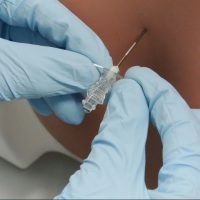Thanks largely in part to growing body acceptance and a new presence of viral, creative tattoo masterpieces, the reputation of stretch marks has improved tremendously in recent years. Growing up as a little girl, I only knew to fear them, so I never imagined a day when I’d be singing along to popular music songs with lyrics praising stretch marks for their natural appeal. (Talk about a comeback story!) As prominent as this particular skin feature has been, and even as someone who now has stretch marks, I still have very little knowledge about them, though. For example, what’s the difference between white and red stretch marks?
Along with millions of other people, I developed stretch marks both during the growth spurts of puberty and later on when I gained a significant amount of weight in adolescence. Adding pregnancy to the list, we start to get a clear idea of the fact that stretch marks are caused by bringing the skin to its capacity, typically in a rapid manner. Some athletes with low levels of body fat still develop stretch marks if they build muscle at an escalated pace; altogether, these categories now show us that these stripes on our skin are not—as it was once fearmongered around—simply a mark of “being fat.”
Why Red?
When our skin develops stretch marks, they often look red, but may also present as purple, pink, blue, or even black, based on skin type and complexion. The reason for these colorful marks, whatever the shade, is that we are seeing the body’s attempts to heal the tear in our skin. The inflammation of the area, while it is under repair, creates a colored effect; however, when the tear is healed, it turns white.
Essentially, our older stretch marks are the white ones. These areas no longer have highly functioning blood vessels, so the skin’s ability to repair itself is hindered, leaving the visual effect of the “stretch mark.” Since we can change our body’s shape in a number of areas, stretch marks can appear anywhere, but they are most commonly visible on our meatiest areas, including the abdomen, thighs, hips, butt, and breasts.
Exceptions
Potential outliers to the norm would include things like breast augmentation surgeries, overusing corticosteroids over time, and two recognized medical conditions: Ehlers-Danlos syndrome and Cushing’s syndrome. In each of these situations, stretch marks are likely to appear, affecting a narrower portion of the population, who are also still potentially prone to “typical” stretch marks. These special situations may create stretch marks that are more resistant to methods of treatment and more apparent or frequent to form.
However, for the vast majority of humans who develop stretch marks, the rules are the same across the board, regardless of age, skin type, or complexion. That being said, it is true that women develop stretch marks 2.5 times more often than men—meaning more women develop them, overall. Genetics is also a factor, as the likelihood of skin presenting these tears is increased if previous generations also visibly have them.
Treatment
There are methods for prevention and treatment, if desired. Of course, there are some things we can’t control, such as weight gain during pregnancy or how quickly our bodies develop during puberty; in these situations, especially if we are genetically prone to stretch marks, we will likely see them no matter what we do.
Only when stretch marks are newer (presenting as red, or one of the other color options discussed earlier) can they potentially be treated with at-home retinoid creams. All stretch marks will heal to white and ultimately fade on their own in time, but during this red phase of their development, the body is still using the blood vessels in the area to try and heal itself, so healing may be responsive to retinoid creams.
Another option is to find a great stretch mark cream to help with prevention and reducing the visibility of red and white lines, alike. The key to this method is to massage the product into the affected areas. While no cream can “cure” stretch marks, they may help reduce their appearance, they will certainly help with any associated itching, and the massaging process may help the healing process of newer, red stretch marks.
For those who might want to eliminate their stretch marks entirely, there are other, more intensive treatment options including light and laser therapy, microdermabrasion, and chemical peels. If your goal is to reduce the appearance in a less-invasive way, there are always the options of self-tanners and body makeup, aside from the stretch mark creams. It’s crucial to note that tanning in the sun will make matters worse—a sunless tanner is an option for its ability to safely even the appearance of skin tone, masking stretch marks quite nicely. Brands like KKW BEAUTY also now offer full-body makeup foundations, which are another excellent option for concealing marks without undergoing any harsh treatments.
Prevention
In terms of prevention, as was mentioned earlier, there are some things we simply can’t control, but there are a few things we can do to help where we can. First of all, making sure we stay active, fit, and healthy is the most basic way to avoid stretch marks brought on by weight gain. Easier said than done, but there we have it. When considering our diet, we should make sure we’re getting enough protein, zinc, and vitamins A, C, and D, as these are all known to improve skin. These elements of our diet are excellent for skin health and can even help decrease the appearance of stretch marks.
Finally, exfoliating the skin in areas where we have stretch marks may help them fade faster. Exfoliating should be done with care and without great frequency, as it can be very harsh on the skin. Done properly, this process will help remove old, dead skin cells, helping usher in new, fresh skin and reducing the appearance of any stretch marks over a shorter period of time.
If you do decide to embrace your stretch marks and showcase them with tattoo art, be sure to remember that only the white marks represent healed skin. Red stretch marks should be treated as injuries to the skin and be given attention to help heal.




